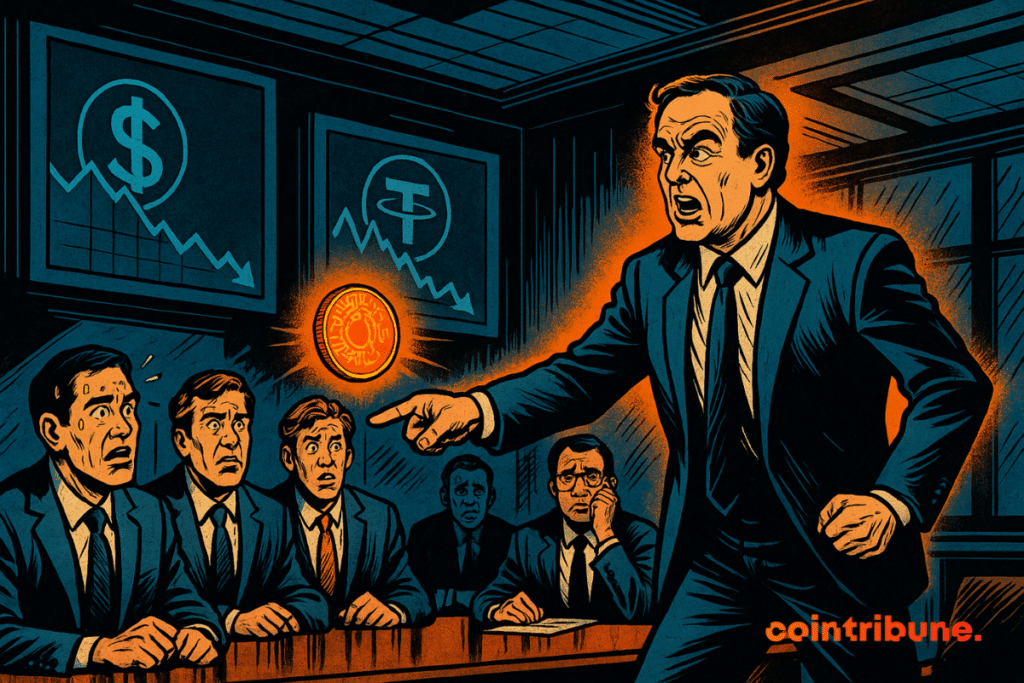Bank of England Governor Warns Banks Against Stablecoins, Pushes for Tokenized Alternatives
Stablecoins have become a widely used medium of cross-border transactions, especially for retail payments and other overseas remittances. Despite the growing adoption, some within the banking circles have expressed skepticism about these digital fiat-pegged assets. A prominent banking personality even warned the world’s largest banks against issuing their own stablecoins.

In Brief
- BOE Governor Andrew Bailey warns top banks against issuing stablecoins, calling them a threat to financial system stability.
- Bailey backs tokenized deposits over stablecoins or CBDCs, citing better integration with traditional banking systems.
- U.S. and EU take diverging crypto paths, with stablecoin regulation and CBDCs topping legislative discussions.
- Stablecoins reach $258 billion market cap, with over 750K weekly Ethereum users.
Andrew Bailey Advocates for Tokenized Deposits
In an interview with British media house The Times, Bank of England Governor Andrew Bailey advised top banks against launching their own fiat-pegged blockchain currency, claiming that stablecoins pose a risk to the financial system.
Bailey explained that the increased patronage of this new form of money could affect the liquidity injection into traditional banking systems and create a separate, unregulated financial system. He added that stablecoins are still in their early days and lack clear regulatory oversight.
The BOE governor suggested that apex banks embrace tokenized deposits, which are the actual digital representation of traditional money. Bailey maintained that it would be “sensible” for banks to go down this lane instead of issuing central bank digital currencies (CBDCs) or private sector stablecoins.
I would much rather [banks] go down the tokenised deposit streets and say, how do we digitise our money, particularly in payments.
Andrew Bailey
Bailey, who also serves as the chairman of the international monetary watchdog Financial Stability Board, cautioned against buying Bitcoin. He asserted that BTC is “not money” and “doesn’t have the function of money.”
The BOE governor emphasized that investors who decide to buy Bitcoin should be careful and fully understand the risks before doing so. BTC broke the $120K mark for the first time on July 14, reaching a new all-time high of $123,191.
U.S. and EU Chart Diverging Crypto Paths as House Debates Stablecoin Rules
Bailey’s statements come on the eve of the House GOP-declared “Crypto Week,” during which both the U.S. lower and upper chambers are set to deliberate on crypto regulations.
As part of the debate, the U.S. House of Representatives will discuss a version of the GENIUS Act, which sets a framework for top firms and financial institutions to issue stablecoins. In addition, the House may also discuss a broader market bill and a measure prohibiting the Federal Reserve from issuing a CBDC.
However, Bailey highlighted that none of these jurisdictions are considering tokenized deposits.
I would say that the US is going towards stablecoins. The European Central Bank is going towards central bank digital currency. Neither of them is going towards tokenising deposits.
Bailey
Bailey has long been a critic of crypto assets. Speaking at the University of Chicago Booth School of Business in London in February, the BOE chief referred to non-stablecoins as “pure investment risk.”
Central Bank Leaders Urge Caution and Regulation for Stablecoins
Bailey isn’t the only high-ranked banking personality with a conservative stance towards stablecoins. Former president of the European Central Bank Christine Lagarde cautioned against stablecoin adoption, claiming that it undermines monetary policies and threatens national sovereignty.
Concerns have also bordered on the lack of clear regulation of these fiat-pegged assets, with some worrying that malicious actors could exploit this lack of oversight for money laundering. To curb this potential risk, some central bankers have called for a more standardized framework similar to traditional banking.
Bailey also supports this idea, hinting that stablecoins should have strict rules. According to him, these coins should be safe and reliable since people use them as regular money.
Stablecoins Show Strong Growth Amid Regulatory Concerns
Despite Bailey’s comments, stablecoins have gained increased traction globally, with the most notable coming in the past few years.
Here’s what on-chain data is saying:
- The total stablecoin market capitalization is $258.533 billion.
- Over the past 30 days, the market cap has increased by 2.71%.
- Ethereum stablecoin senders reached a new all-time high in June, with over 750,000 unique weekly users.
- This growth includes major stablecoins such as USDT, USDC, BUSD, and DAI.
This trend demonstrates the increased institutional attention gained by these assets and the growing adoption by users. More so, the recent growth within the past year suggests that the stablecoins may be flipping speculative interest into real utility-based adoption.
Maximize your Cointribune experience with our "Read to Earn" program! For every article you read, earn points and access exclusive rewards. Sign up now and start earning benefits.

James Godstime is a crypto journalist and market analyst with over three years of experience in crypto, Web3, and finance. He simplifies complex and technical ideas to engage readers. Outside of work, he enjoys football and tennis, which he follows passionately.
The views, thoughts, and opinions expressed in this article belong solely to the author, and should not be taken as investment advice. Do your own research before taking any investment decisions.